*If you want to keep abreast of new posts as they come out, follow me on Facebook or Pinterest through the links above.
Art shapes our world in many ways, creating a rich cultural and historical backdrop. Exploring diverse art genres shows us a world of styles of artwork. Each style tells us about different times and cultures. Art has evolved from ancient times to now, showing us the human experience.
Artists add their own thoughts and feelings to their work. This journey through unique artistic expressions connects us with art lovers and creators worldwide.
These styles of artwork started in the West and spread, touching many lives. Exploring diverse art genres helps us see how art reflects our world’s values and feelings.
*This article contains affiliate links, and I may receive a small commission after you click one of these links at no extra charge. As an Amazon associate, I earn from qualifying purchases.
Key Takeaways
- Understanding diverse art genres enhances appreciation of cultural evolution.
- Styles of artwork mirror the historical and societal contexts of their times.
- Unique artistic expressions connect us to past ideologies and philosophies.
- Exploring various art styles can deepen the general understanding of visual language.
- Recognizing the Western origins of art movements contributes to a global perspective on art.
Society6 has a wide variety of art prints at prices for every budget.
Are you in need of frames for your artwork? Try Framebridge.
The Significance of Art Movements and Style
Art movements have changed the way we see the world. They show us the ideas and values of their time. By looking at these movements, we learn about the history and culture that shaped art.
Art movements range from the beauty of Ancient Greece to the bold Avant-garde. Over 100 art movements exist, about 40 of which date from the 19th century. This shows how art keeps changing.
- Classicism: Started in the 5th century BC, it focuses on beauty and balance. It captures the human form and landscapes with perfect beauty.
- Renaissance Art: Lasted from 1300 to 1600, it was a time of rebirth. It emphasized realism and feelings through light and perspective, with famous artists like Leonardo da Vinci and Michelangelo Buonarroti.
- Mannerism: Started around 1520-1580, it reacted against the High Renaissance. It’s known for its stretched figures, bright colors, and strong feelings.
- Baroque: This style, which lasted from 1600 to 1750, used light and shadow for drama. Its movement and rich colors aimed to make viewers feel deeply.
Art movements use many techniques like sculpture and painting. They add depth to art. Artists from around the world have influenced these movements, pushing art into new areas.
Exploring art movements helps us see how art has changed. It shows us the big ideas and changes in society. Every style tells a story of human creativity and culture.
Art history teaches us about the past and inspires us for the future. It shows why understanding art movements and styles is important for our culture.
Renaissance Art: A Foundation for Creativity
The Renaissance, which lasted from the 14th to the 16th centuries, was a key period in art history. It changed art in big ways and greatly influenced art styles and art education.
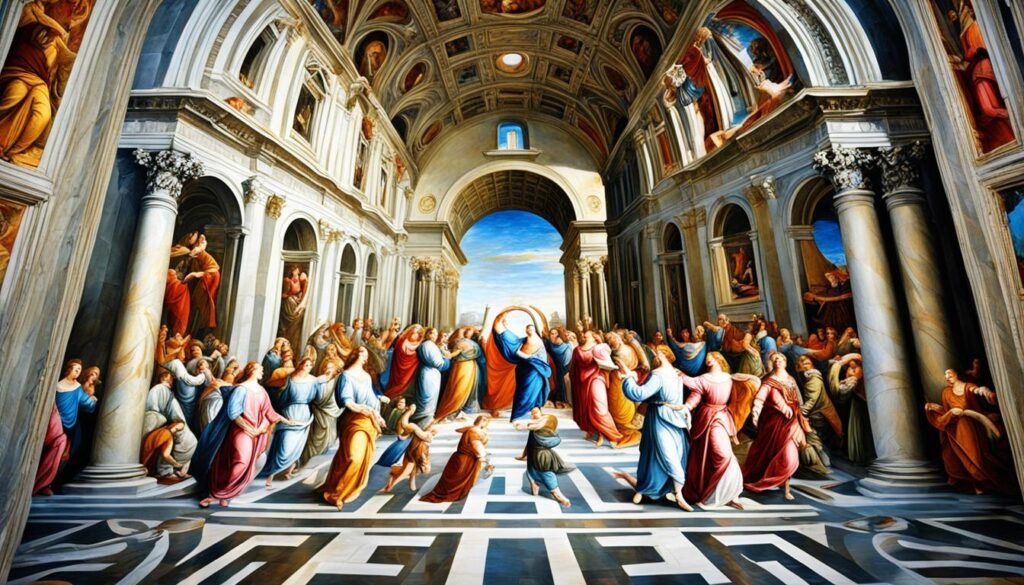
This period focused on naturalism and humanism. It brought back classical learning from Ancient Greece and Rome. Artists like Leonardo da Vinci, Michelangelo, and Raphael used new techniques. They added realistic depth to their art with linear perspective.
- Humanism: Focusing on human interests, capabilities, and individualism, Renaissance art showed human beauty and potential.
- Naturalism: Artists were inspired by Classical sculptures. They aimed for lifelike accuracy, making it key to Renaissance art.
- Chiaroscuro and Sfumato: These techniques allow artists like Leonardo da Vinci to add texture and depth with light and shadow.
The Renaissance changed art styles and established practices that lasted for centuries. Works like Raphael’s ‘The School of Athens’ show the era’s focus on balance and perfection in art, science, and philosophy.
The High Renaissance lasted about thirty years and was short but creative. Artists improved their skills, such as showing human anatomy accurately, which set the stage for future art.
The Renaissance’s impact is still seen today, particularly in art education and the study of Renaissance art styles.
Baroque Art: Drama and Dynamism
Baroque art began in Italy in the late 16th century. It brought a new era of drama and grandeur. Artists like Caravaggio used dramatic realism and movement to tell stories.
-
- Origins and Influence: The word “Baroque” might come from Italian ‘barocco’ or Portuguese ‘barroco,’ meaning complex and irregular. It was a response to the Mannerist style. The Roman Catholic Church used it to make people feel more devoted.
- Characteristics: Baroque art is known for its emotional depth and vibrant energy. It uses sensuous richness and movement to create powerful feelings, and this style aims to make viewers feel deeply moved.
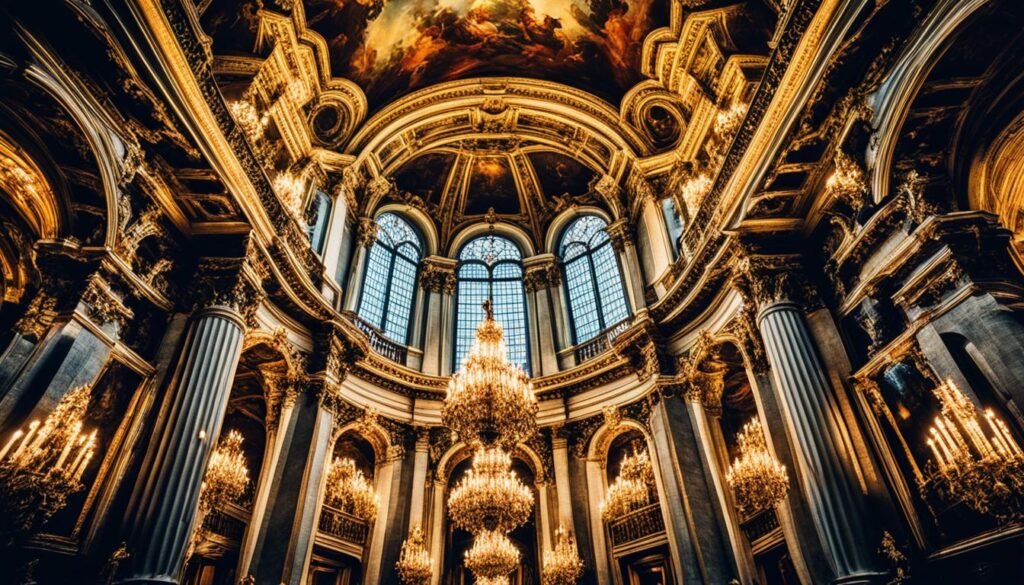
- Techniques and Styles: Artists used chiaroscuro to make their scenes look real and deep. This technique made the contrast between light and shadow striking. It led to stories that were visually stunning and influenced art for years to come.
- Caravaggio’s Impact: Caravaggio changed Baroque painting with his lifelike figures full of emotion. His work still affects today’s art, showing how his style is still loved.
- Societal Influence: The rise of absolute monarchies and a growing middle class changed art patronage. This led to a market for grand art in palaces and public spaces. It showed how society and science were expanding.
Baroque art is a crucial part of art history. It shows a mix of grandeur and real human feelings. It proves how art can change culture and beliefs over time. The drama and feelings of Baroque art still inspire today’s artists.
Neo-Classicism and The Pursuit of Harmony
The Neo-Classicism movement was a major change in art, bringing back classical simplicity and grandeur. It started in the 1760s and lasted until the 1850s. Thanks to new archaeological finds, this movement was inspired by ancient Greece and Rome.
Artists like Jacques-Louis David looked to history and classical ideals for inspiration. They painted grand scenes of Roman history or myth. This was more than just a style; it was a way to show virtues like heroism and patriotism during hard times.
At traditional art schools, they taught the ways of Neo-Classicism. They focused on balance, symmetry, and harmony. These schools helped artists stick to classical techniques and motifs, as seen in Jacques-Louis David’s paintings. His works, like “The Death of Socrates,” show how Neo-Classicism was more than just a style.
Neo-Classicism also changed architecture, favoring simplicity and precision. It looked up to ancient civilizations for building and sculpting inspiration. This led to a comeback of classical architectural styles, seen as clear and rational.
- Education and Influence: Traditional art schools were key in sharing Neo-Classicism’s ideals. They taught a disciplined art approach that valued history and culture.
- Artistic Techniques: Neo-Classicism focused on lines over colors. This made art clear and precise, reflecting the Enlightenment’s rational and moral views.
- Cultural Impact: Neo-Classicism, through artists like Jacques-Louis David, sent strong moral messages. It helped build civic pride, fitting with the era’s social reforms.
In short, Neo-Classicism was more than an art style. It was a cultural movement that aimed to use art to teach society. It celebrated the human spirit with a revival of classical dignity and grandeur.
Embracing Reality in Realism
Realism started in the mid-19th century and changed the art world. It focused on painting life truthfully, without idealizing it. This movement showed the gritty realities often missed in art. Gustave Courbet was a key figure, known for his realistic art and deep social commentary.
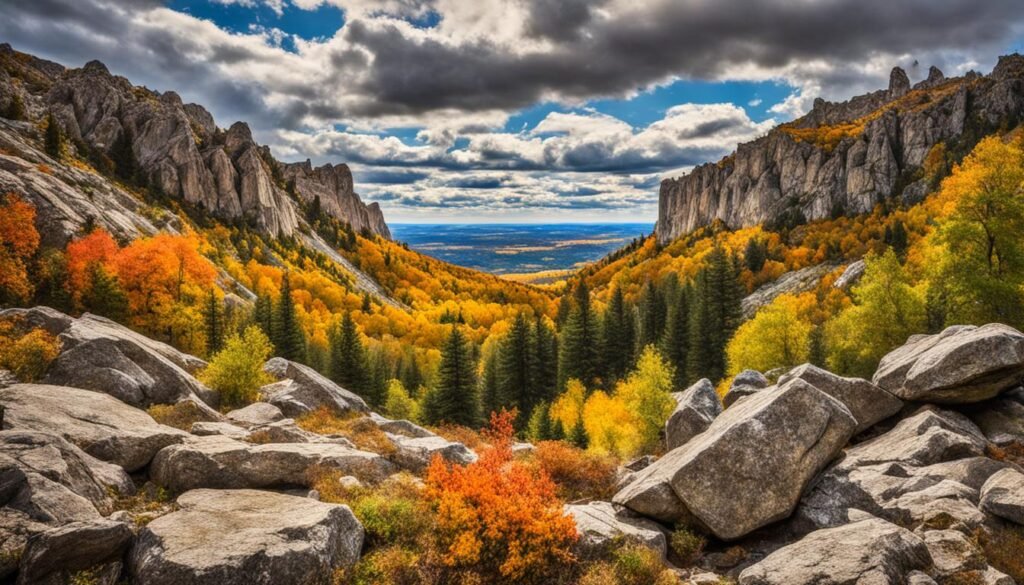
Realism started a new conversation about art’s role in society. It used art techniques to engage viewers beyond just looking at beauty. Realist painters showed the hard truths of everyday life, especially for the working class. They focused on ordinary people doing everyday tasks, a change from the grand subjects before.
- Gustave Courbet, with works like “The Stonebreakers,” exposed the rough life of laborers, intertwining artistic beauty with political commentary.
- Jean-François Millet touched hearts with “The Gleaners,” highlighting the backbreaking work of rural peasantry.
- Honoré Daumier’s “Third-Class Carriage” provided a candid look into the crowded conditions of public transport for the everyday person.
These paintings were more than just art. They acted as mirrors to society, making people think about and question the social norms. Realism’s impact has lasted centuries, influencing art movements like Impressionism and today’s Realist works. It still makes people think and feel deeply.
Learning about Realism is key to understanding the evaluation of visual arts. By looking at Realist painters and their work, we see how art reflects society’s values and struggles. This continues to affect and move people worldwide today.
Impressionism: Capturing Light and Color
Impressionism started in France in the late 19th century. It was a big change from traditional painting methods. Artists like Claude Monet and Edgar Degas painted outside to catch light and color in action.
This new method of painting changed how people saw art and introduced a fresh way of seeing the world.
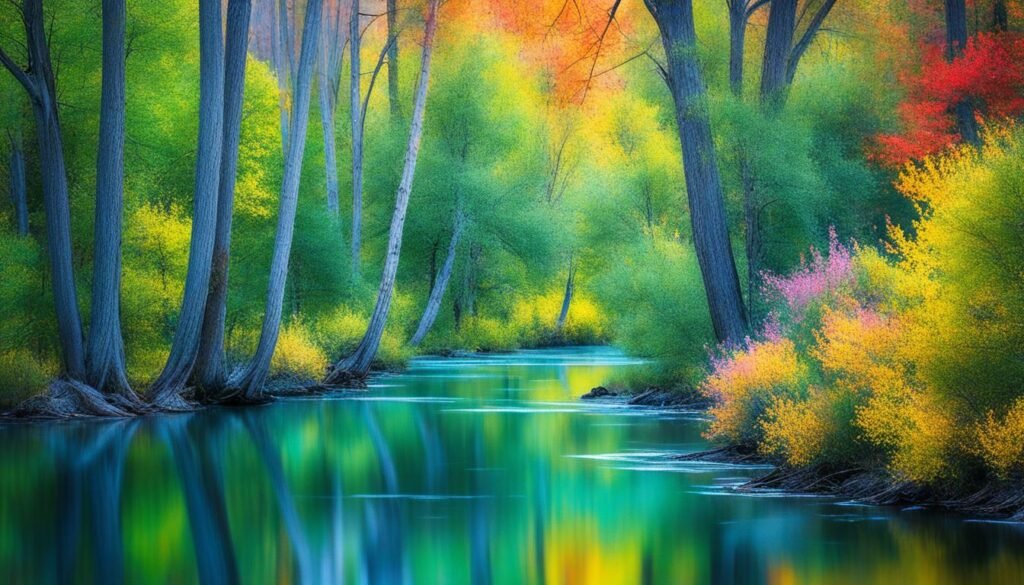
Impressionist paintings are known for their free brushwork and bright colors. Claude Monet led this movement. He used sunlight and atmosphere to show life’s fleeting moments.
His painting ‘Impression, Sunrise’ shows more than just a scene. Thanks to Monet’s skill with light, it captures a feeling. This painting is key to Impressionism, showing the beauty of nature.
Impressionism also changed art in everyday life and culture. It made people value experiences over things. Artists used color and perspective in new ways, pushing art forward.
Monet and others still inspire art lovers worldwide today. Their work with light and color is a big part of modern art, keeping the spirit of Impressionism alive.
Pointillism and Beyond: Advances in Artistic Technique
Pointillism grew out of Impressionism, bringing new ways to use color and light. Georges Seurat and Paul Signac started it in the late 1800s. They used small dots of color to make images, creating a unique look.
This method changed how artists thought about color and light. It also led to new ideas in color theory and how we see things. Pointillism mixed art and science, offering new ways to use color.
Artists like Henri Matisse and Van Gogh used Pointillism to make their work pop. They added bright colors that seemed to jump off the canvas. This style changed how artists thought about brush strokes and details.
Pointillism also influenced other art movements, like Fauvism, which used bold colors. Today, it even affects digital art, where pixels work like dots to change how we see things.
Georges Seurat is a key figure in art history because of Pointillism. His work inspired many artists and changed art forever. Seurat showed how careful use of color could create amazing effects, starting a new chapter in art.
Art Nouveau to Contemporary: The Evolution of Form
The shift from Art Nouveau to contemporary art trends shows how art has changed over time. This movement started in the late 1800s and was known for its organic shapes and intricate designs. It also had a strong connection to nature, influencing many diverse art genres.
Art Nouveau, also known as Jugendstil in Germany and Stile Liberty in Italy, aimed to combine fine and applied arts. This movement helped create modern art styles, focusing on how form follows function.
Gustav Klimt was key in moving from Art Nouveau to modern art. His famous “Portrait of Adele Bloch-Bauer I” shows a mix of old and new styles. Klimt’s work enriched art and influenced contemporary art trends, linking the past and present.
- Art Nouveau’s International Reach: It thrived from 1890 to 1910 and was showcased at the 1900 Exposition Universelle in Paris. It spread globally, with names like Sezessionstil in Austria and Modernismo in Spain.
- Revival and Lasting Influence: After a decline, Art Nouveau returned in the 1960s, affecting Pop and Op art. This comeback showed its lasting impact and role in modern art.
- Diverse Evolutions: Art Nouveau’s focus on nature and flowing lines evolved into today’s diverse contemporary art. Now, art combines form and function in new ways.
Today, the link from Art Nouveau to contemporary art trends is clear. Artists keep exploring and building on old ideas. This journey shows how art has changed and still reflects our society.
Conclusion
We’ve taken a deep dive into the art history of different cultures and times. This journey shows how art has changed from the structured beauty of Renaissance art to the boldness of Fauvism and Expressionism. Each style tells us about the stories of its time, society, and our shared human experiences.
Most Drawing 1 and Painting 1 projects focus on art history, showing its lasting importance. They highlight the need to understand how art has evolved. This includes everything from traditional canvas art to lively street art that speaks for the unheard.
Many students see the value in learning from past artists to improve their critical thinking. By studying artists like Emma Talbot and street artists, we gain deeper insights into their work and its context.
We also see areas where research and presentation could get better, leaning towards a more journalistic style. This shows how learning and sharing information are blending together. Sites like Khan Academy and Google Arts Project are praised for helping teach art.
As we conclude our examination of art styles, from detailed drawings to community projects, we see its big impact. Art shapes societies and reflects our deep creative nature.

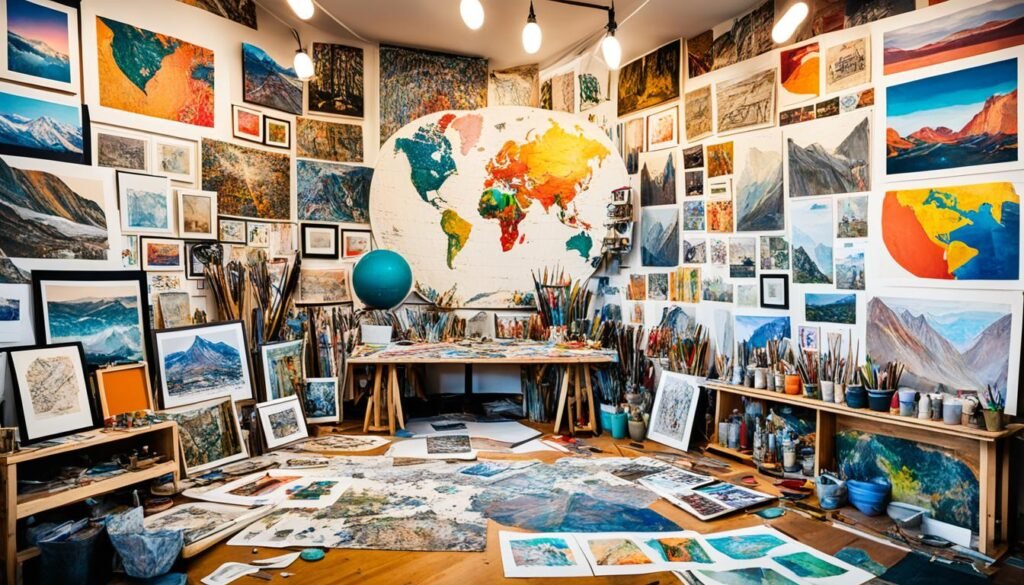
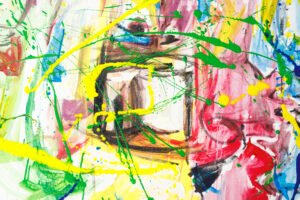



[…] Explore the World of Different Art Styles (artistichomevibes.com) […]